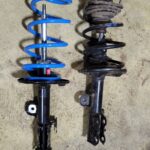
Last season was my second season of 3 gun and while I’ve upgraded my pistol and shotgun, I hadn’t really messed around too much with my rifle. Its destiny to stay unchanged was rocked at the second last match of the year. I had a pile of close shooting to do, followed by some farther stuff that needed to be shot through a V-Tac. That particular part of the stage was a disaster for me. All the close stuff scored fine but on the longer range stuff, I was all over the place. Even with carefully placed shots, I could see the hits missing the target. That was a rude reminder that my barrel didn’t really like to get hot. That blew my match and frustrated me to no end, so I thought I’d upgrade my barrel to one from CTC Supplies.
Much of an AR15’s accuracy comes from the inherent simplicity of the action and a great barrel. With the bolthead locked into the barrel extension and a free float handguard, there’s not much influencing the shot other than the quality of the bore that the barrel is going through and the nut pulling the trigger. My Spike’s Tactical 16″ barrel was pretty decent when it was cool, turning in 2″ groups fairly easily, but it didn’t like getting hot. My solution was a heavier match barrel from Rainier Arms.
The Rainer Arms barrel I chose was 16″ in length so that I could squeeze out some velocity for longer range shots, but still short enough that it was handy around obstacles. I went for the Wylde chambering so that I could safely and accurately fire both 223 and 5.56 spec ammo. I thought the matte stainless barrel would look good with the rest of my white AR15. And the 1:8 twist better matched the weights of bullets that I’d be likely using compared with my previous 1:7. 1:7 would be great if I was shooting heavy weight bullets out to long range, but 99% of my shooting is with cheap “blaster ammo” that’s usually around 55 grains. A 1:8 is more than acceptable for that weight range. The gas tube length on the Rainier Arms barrel was mid-length, which is better suited for a 16″ barrel than a carbine length gas system which was on the older barrel. The fact that the barrel was guaranteed sub-MOA with match-grade ammo didn’t hurt either. The SPR contour is heavier than the M4 gov style contour and doesn’t include a spot for an M203 grenade launcher to be installed, but that’s a tradeoff I’m willing to live with.
If you haven’t installed a barrel on an AR15, you’re in for a real treat. Compared with changing the barrel on a modern bolt action rifle, or yester-year’s battlerifles like the M14 or Garand, changing a barrel on an AR-15 is super easy.
- Take your upper off your lower.
- Pull off your muzzlebrake, forend, gas block with gas tube.
- Put the upper on a block of some kind (I used the Magpul BEV block)
- Using an AR15 barrel wrench, loosen and remove the barrel nut
- Pull the old barrel off.
- Put the new barrel in.
- Install and torque the barrel nut to correct specifications.
- Reinstall all the goodies you took off. I had to use a new gas tube since my old one was the wrong length, but my old low profile gas block worked just fine.
That sounds like a lot of steps, but it’s really no more than 10 minutes worth of work. You’ll likely spend more time futzing around with getting the gas tube out of the old gas block if you need to (they really get stuck in there over years of use), or with correctly timing the muzzlebrake to perfectly center.
You should also check headspace with a Go/No-Go gauge just to be safe. When buying high quality parts, a headspace issue in an AR15 is unlikely, but these gauges are inexpensive peace of mind.


Results
The new barrel contour is a bit heavier than the old one I had. The new one is 1.16kg while the old one was 0.80kg. That gave my rifle a more weight forward feel.
But who really cares? How about the accuracy!? Well, the accuracy was vastly improved both cold and pretty warm. My blaster ammo (PMC 55 grain) dropped from ~2″ to ~1″, while better stuff all printed within a 1″ box. The barrel should also better resist the effects of shooting from weird shooting positions and leaning against barriers.







